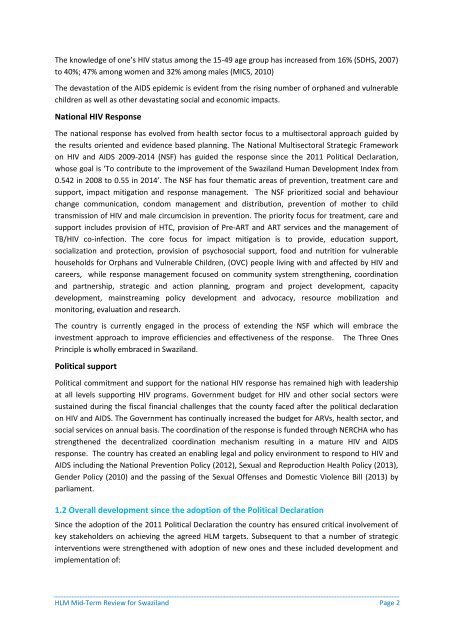Swaziland FINAL_HLM_MTR Stock-Taking Final Report 2013.pdf
Swaziland FINAL_HLM_MTR Stock-Taking Final Report 2013.pdf
Swaziland FINAL_HLM_MTR Stock-Taking Final Report 2013.pdf
- No tags were found...
Create successful ePaper yourself
Turn your PDF publications into a flip-book with our unique Google optimized e-Paper software.
The knowledge of one’s HIV status among the 15-49 age group has increased from 16% (SDHS, 2007)to 40%; 47% among women and 32% among males (MICS, 2010)The devastation of the AIDS epidemic is evident from the rising number of orphaned and vulnerablechildren as well as other devastating social and economic impacts.National HIV ResponseThe national response has evolved from health sector focus to a multisectoral approach guided bythe results oriented and evidence based planning. The National Multisectoral Strategic Frameworkon HIV and AIDS 2009-2014 (NSF) has guided the response since the 2011 Political Declaration,whose goal is ‘To contribute to the improvement of the <strong>Swaziland</strong> Human Development Index from0.542 in 2008 to 0.55 in 2014’. The NSF has four thematic areas of prevention, treatment care andsupport, impact mitigation and response management. The NSF prioritized social and behaviourchange communication, condom management and distribution, prevention of mother to childtransmission of HIV and male circumcision in prevention. The priority focus for treatment, care andsupport includes provision of HTC, provision of Pre-ART and ART services and the management ofTB/HIV co-infection. The core focus for impact mitigation is to provide, education support,socialization and protection, provision of psychosocial support, food and nutrition for vulnerablehouseholds for Orphans and Vulnerable Children, (OVC) people living with and affected by HIV andcareers, while response management focused on community system strengthening, coordinationand partnership, strategic and action planning, program and project development, capacitydevelopment, mainstreaming policy development and advocacy, resource mobilization andmonitoring, evaluation and research.The country is currently engaged in the process of extending the NSF which will embrace theinvestment approach to improve efficiencies and effectiveness of the response. The Three OnesPrinciple is wholly embraced in <strong>Swaziland</strong>.Political supportPolitical commitment and support for the national HIV response has remained high with leadershipat all levels supporting HIV programs. Government budget for HIV and other social sectors weresustained during the fiscal financial challenges that the county faced after the political declarationon HIV and AIDS. The Government has continually increased the budget for ARVs, health sector, andsocial services on annual basis. The coordination of the response is funded through NERCHA who hasstrengthened the decentralized coordination mechanism resulting in a mature HIV and AIDSresponse. The country has created an enabling legal and policy environment to respond to HIV andAIDS including the National Prevention Policy (2012), Sexual and Reproduction Health Policy (2013),Gender Policy (2010) and the passing of the Sexual Offenses and Domestic Violence Bill (2013) byparliament.1.2 Overall development since the adoption of the Political DeclarationSince the adoption of the 2011 Political Declaration the country has ensured critical involvement ofkey stakeholders on achieving the agreed <strong>HLM</strong> targets. Subsequent to that a number of strategicinterventions were strengthened with adoption of new ones and these included development andimplementation of:<strong>HLM</strong> Mid-Term Review for <strong>Swaziland</strong> Page 2
















